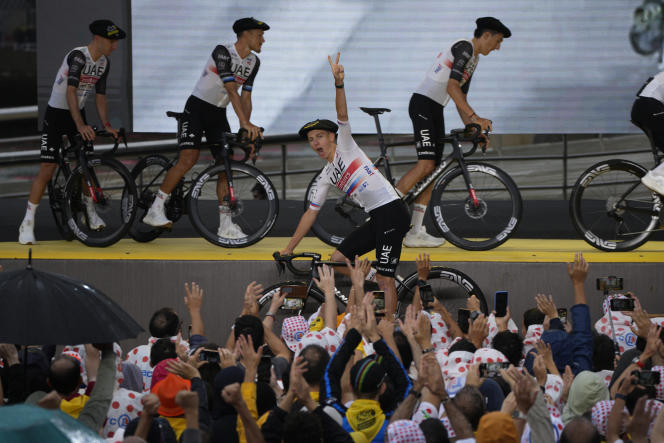For Christian Prudhomme, the director of the Tour de France, Basque cycling is inseparable from the orange tide of Euskaltel-Euskadi supporters, massed on the edges of the Pyrenean roads to encourage their champions. The local team, today in Pro team – the equivalent of the second division -, was not invited to this Grande Boucle 2023 (from 1er to July 23). But Thursday, May 29, in Bilbao (Spain), when the 176 riders entered in this edition bowed to the traditional parade preceding the big start, a fervor similar to that described by the boss of the event was all likewise there.
At the end of the afternoon, at the foot of the Guggenheim museum, an architectural jewel of the American Frank Gehry dedicated to modern and contemporary art, yellow scarves with the effigy of the Tour de France, the ikurriña (the Basque flag ) and orange hats with the Euskaltel logo were numerous. They contrasted with the gray skies of the capital of Biscay, one of the three provinces of the Spanish Basque Country. In front of them appeared, one by one, the twenty-two teams involved, most of them having also worn a beret for the occasion, another local symbol, very useful when the rain was invited to the party.
Not enough to shower the good mood of the public, noisier as the regionals pass, such as Pello Bilbao and Mikel Landa, from Bahrain-Victorious, or even Ion Izagirre, member of the Cofidis team. Or when the Slovenian Tadej Pogacar, double winner of the race (2020, 2021), launched a “Gora Euskadi” (“Long live the Basque Country”) to the crowd.
Can we really be surprised? At the top of the homepage of the siteEl Correo, the leading daily newspaper in the Basque Country, had already been displaying a countdown for several days showing the time remaining before the big start. More than two years earlier, when Amaury sport organization (ASO), the manager of the Tour, had confirmed that the caravan would set up shop in the region in 2023, the title was already rejoicing to host the third sporting event on a planetary scale, after the Olympics [d’été] and the World Cup [masculine] of football “. “Bilbao will attract global spotlights with an event whose images will be broadcast in 190 countries, with a potential audience of 3.5 billion viewers. »
Political instability
The newspaper mainly recounted the long-term work, carried out behind the scenes by the town hall, the Provincial Council of Biscay and the government of the Basque Country to convince the Grande Boucle to return to a region where it had already passed three times: in 1949 in San Sebastian, in 1977 with an arrival and departure in Vitoria, and finally in 1992. That year, San Sebastian was the host city of the big departure and, icing on the cake, a native of the country, the Navarrese Miguel Indurain won the prologue before finishing in yellow on the Champs-Elysées.
Since… no Grand Tour. Because, during this 1992 edition, two explosions had occurred the day before the start in a public car park in the city center, near the hotel of the management of the event. The symbol of a region over which the shadow of ETA hovered, the independence organization Euskadi ta Askatasuna (“Basque Country and Freedom”), now dissolved.
Created in 1959, it had already hindered the smooth running of the Vuelta on several occasions. In 1968, a bomb exploded just before the arrival of the peloton during a stage between Vitoria and Pamplona, without causing any deaths. Ten years later, tree trunks and studded planks were placed across the route of the 19e stage, between Amurrio and San Sebastián, to prevent the passage of following cars.
Cycling had nevertheless returned to the Basque Country in 1997 for the world championships which, again, had not escaped the political instability of the region – a car bomb had injured three civil guards. It is only in 2011 that the region will make its return to the map of the Tour of Spain, another event managed by ASO. What hope that the barnum of the Grande Boucle settles there again. After thirty-one years of absence, it is now done.
